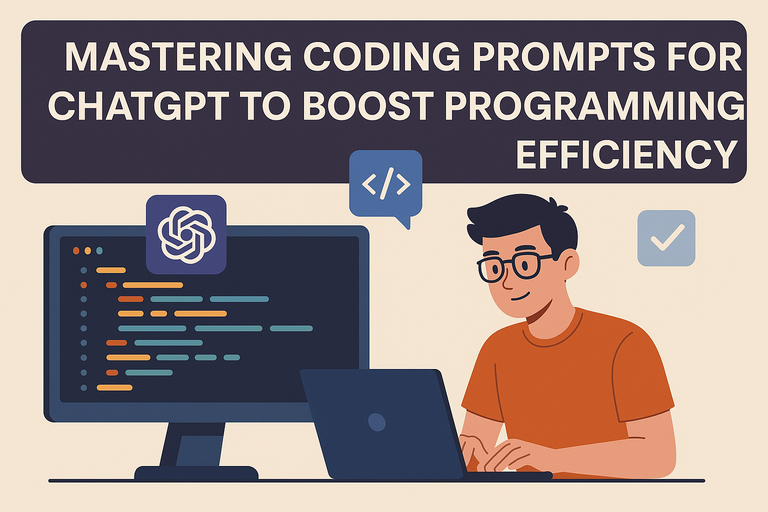Mastering Coding Prompts for ChatGPT: A Developer’s Guide to AI-Powered Programming Efficiency
Estimated reading time: 8 minutes
Key Takeaways
- ChatGPT can be a powerful assistant for generating, debugging, and refactoring code when prompted correctly.
- Effective prompts require specificity, context, and a structured approach to yield precise outputs.
- Advanced techniques like iterative refinement and chain of thought can further enhance AI-driven coding workflows.
Introduction
ChatGPT is a sophisticated large language model developed by OpenAI that excels at natural language generation and code understanding. Beyond casual conversation, it’s a powerful tool that can significantly enhance programming productivity when properly prompted.
According to recent studies, AI tools like ChatGPT can dramatically reduce development time while offering fresh perspectives on coding challenges.
What Is ChatGPT and How It Serves as a Programming Assistant
ChatGPT is a transformer-based large language model trained on diverse internet data, now used to generate, refactor, and debug code. As a programming assistant, it can help with various development tasks when guided by well-crafted prompts.
- Code generation from scratch
- Debugging and error resolution
- Technical guidance and best practices consultation
Best Practices for Crafting Effective Coding Prompts
Be Specific and Provide Context
When creating prompts, you must specify:
- Programming language (Python, JavaScript, etc.)
- Exact functionality required
- Project environment details
- Libraries and frameworks in use
“Specificity in prompts leads to more accurate and useful responses”
Structure Your Prompt Effectively
Follow this structured approach:
- Place instructions at the beginning
- Use markers (
###or""") to separate code and instructions - Follow the sequence: task description → formatting instructions → sample code → context
“Using clear markers and logical structure significantly improves ChatGPT’s code output”
For more on optimizing your prompts, see the guide.
Define Inputs and Outputs Clearly
Always specify:
- Input formats and data types
- Expected output behavior
- Edge cases to handle
“Explicit input/output specifications result in more precise code generation”
How to Generate Code with ChatGPT Prompts
Step 1: Instruct, Don’t Ask
Use direct commands instead of questions:
- ✓ “Write a JavaScript function that…”
- ✗ “Can you show me how to…”
“Direct instructions yield better results than questions”
Step 2: Provide Examples
Include:
- Sample input values
- Expected output examples
- Edge case scenarios
“Example-driven prompts help ChatGPT understand requirements better”
Step 3: Sample Prompt
Debugging Prompts with ChatGPT: Identify and Fix Code Issues
When debugging with ChatGPT, include:
- Complete code snippet
- Full error messages
- Expected vs. actual behavior
- Environment details (language version, libraries)
Example debugging prompt:
“Debug this JavaScript code that should add items to a shopping cart but returns ‘undefined’. Include error cause and corrected code.”
“Comprehensive context is crucial for effective debugging assistance”
For common mistakes to avoid, refer to the linked resource.
Developer Prompt Examples
Function Creation
Architecture Design
Example: “Design a database schema for an e-commerce app with users, products, orders, reviews; include tables, relationships, indexing.”
Documentation
Example: “Generate JSDoc comments for the following React component handling user authentication.”
Advanced Prompt Engineering Techniques
Iterative Refinement
Start with basic prompts and progressively refine them based on responses. Address missing or incorrect aspects in subsequent prompts.
“Iterative refinement leads to higher quality code output”
Learn more about advanced techniques in few-shot prompting.
Chain of Thought Prompting
Guide ChatGPT step-by-step:
- Outline structure
- Implement core logic
- Handle edge cases
“Breaking down complex tasks improves solution quality”
Integrating ChatGPT into Your Development Workflow
Maximize efficiency by using ChatGPT to:
- Generate boilerplate code
- Create unit tests and test cases
- Refactor legacy code
- Translate between programming languages
“ChatGPT excels at automating routine development tasks”
“Code translation and refactoring capabilities save significant development time”
Conclusion and Next Steps
Mastering coding prompts for ChatGPT requires understanding the importance of specificity, structure, and advanced techniques. By implementing these practices, you’ll accelerate development and reduce errors in your coding projects.
We encourage you to experiment with these prompts and share your developer prompt examples in the comments below.
FAQ
Q: What makes a prompt effective for ChatGPT?
A: An effective prompt is clear, specific, and provides all necessary context such as language, functionality, and examples.
Q: How long should a sample input in a prompt be?
A: Keep sample inputs concise but comprehensive enough to illustrate normal and edge case scenarios.
Q: Can ChatGPT generate production-ready code?
A: ChatGPT can provide high-quality code snippets, but you should always review and test before deploying.
Q: Is iterative refinement necessary?
A: Yes, iterative refinement helps fix issues and clarify requirements based on ChatGPT’s initial responses.
